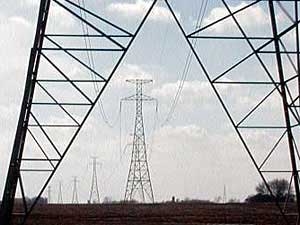|
Audio
Photos
More from MPR
Resources
|
August 29, 2005
A group of power companies hope to build several new and upgraded transmission lines in western Minnesota. The lines will carry electricity from a planned expansion of the coal-fired Big Stone Power Plant in South Dakota. Wind energy supporters say the lines should also carry renewable energy. They're dissatisfied with the plans they've seen so far.
Worthington, Minn. — The argument is over how much electricity the new lines should carry. Six utilities, including lead developer Otter Tail Power Company, plan to build a second generating unit at Big Stone, near the Minnesota border.
Current transmission lines are incapable of carrying the extra load, so the utilities want to build new lines that are able to deliver 230,000 volts of electricity.
Brent Olson, who heads a group planning to build the first wind farm in west central Minnesota, says that's not big enough. Olson wants the new lines large enough to carry the extra Big Stone power, as well as future renewable energy projects.
"We just really hope that Otter Tail will be willing to size their lines appropriately so we can put some renewables on them," says Olson. "It just seems like such a terrific opportunity for everyone."
Olson says power line capacity is one of the most important items in building wind farms. He worries the new lines will be filled to capacity with Big Stone's coal- generated power, leaving little room for wind and other renewable energies.
"We would like to get something more out of it than just the pollution," says Olson. "It's across the border in South Dakota, we really don't benefit too much from it economically. It would be nice to get something out of it."
The Big Stone project includes two separate power line corridors. The southern transmission line runs about 90 miles to Granite Falls. The northern route is about 60 miles long and will end at either Morris or Willmar.
Big Stone spokesman Steve Schultz says talks are taking place concerning the size of the lines. Schultz says the utilities may change the planned 230,000 volt southern route.
"They're looking at that as a possibility, building that at 345,000 volts," says Schultz. "Which would allow more outlet capability for wind projects."
Wind supporters say if that happens it's a step forward, but they also want the northern route upgraded to a larger carrying capacity. Wind advocate Brent Olson says only the larger size will guarantee room on the transmission lines for renewable energy.
The question of line size will ultimately be decided by the Minnesota Public Utilities Commission. The PUC will also decide the exact route of the lines.
Schultz says public comment plays a big role in planning the transmission facilities.
"Nobody is very excited about a power line close to where they live, and we're sensitive to that," says Schultz. "The Minnesota process allows for a lot of public input, and a lot of different thoughts go into the process."
Anyone in the path of the power lines may want to pay a lot of attention to the process. Minnesota statute typically allows the use of eminent domain in power line construction, if property owners are not willing to allow transmission towers on their land.
The Big Stone group is expected to send its power line proposal to the PUC next month. Schultz expects it will take about a year to get the lines approved. Construction of the new power plant may start in about two years. It's expected to begin producing electricity in 2011.






